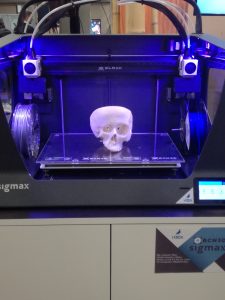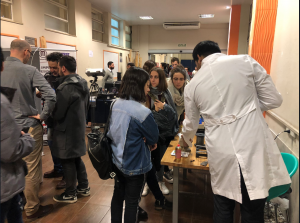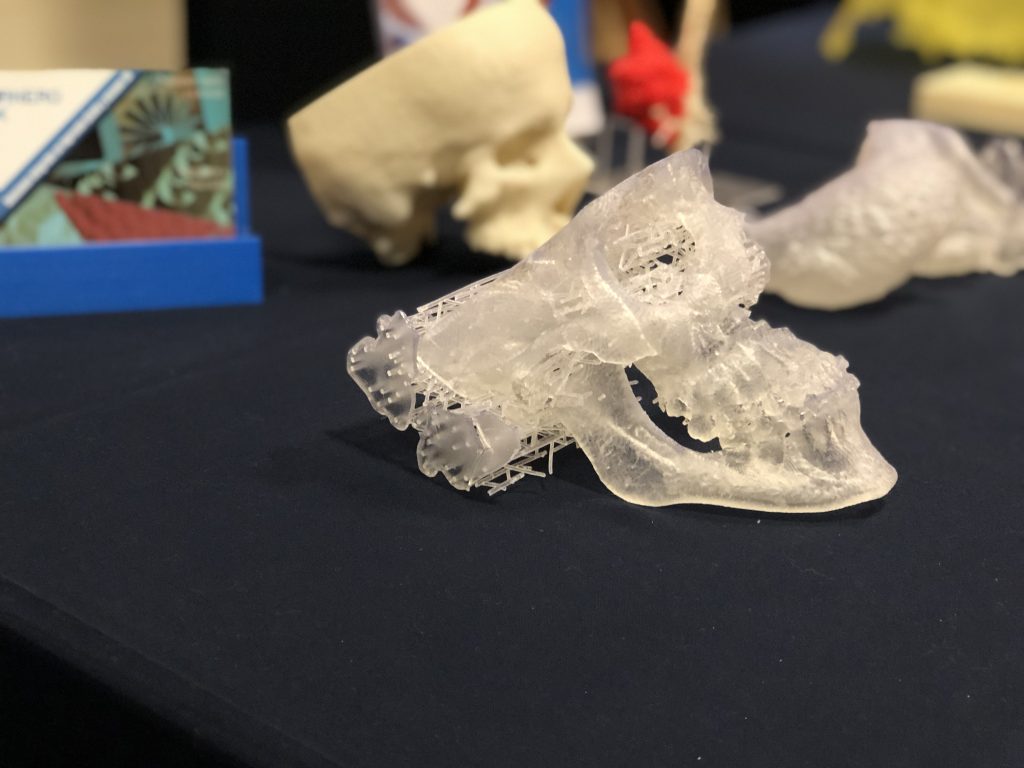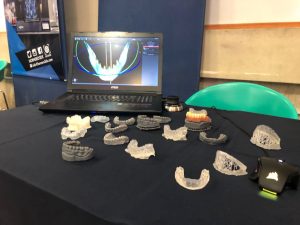3D Print Week (Si3d) at the Technological Institute of Buenos Aires (ITBA), Argentina, brought together local experienced 3D printing and additive manufacturing professionals. From entrepreneurs to students, industry experts and academia, even medical and dental professionals were invited to network in an environment embracing the impact of 3D printing in the industry and healthcare sectors. Attendees were also able to print their projects for free at the fully-equipped university 3D Lab, which is home to a Stratasys J750 PolyJet 3D printer, two Fortus 250mc, a Fortus 450mc, an Objet Alaris30, a CNC machine, and two desktop printers. The two-day event aimed to highlight the growing capabilities of 3D printing in the region, also provided the industry a place to discuss the future of 3D technology. Experts from ITBA, Stratasys, Hornero 3DX, and Garrahan Children’s Hospital shared their experiences with 3D printing models, materials and applications. Some of the topics discussed included 3D bioprinting, 3D facial scanning, and software, 3D printing in a nuclear power station, as well as the making of splints using 3D scanning and 3D printing. Si3d is a must-attend on the annual calendar in Argentina, where only two major 3D printing events take place every year and the local 3D printing industry is taking longer than expected to take-off.
Aeronautic engineer and co-founder of Hornero 3DX, one of the leading companies in Argentina providing 3D printing solutions for public and private sectors, Federico Bertoli, spoke to 3DPrint.com about the tough reality facing most of the local 3D printer developers.
“In 2014 we began designing 3D printing machines, but the lack of incentives for local manufacturers (who have to compete with cost-effective Chinese 3D printers), a decrease in investment for start-ups and very low financing for tech firms, made our venture a very high-risk investment, so we decided to import machines that could satisfy our customers needs,” said Bertoli, who had on display some of the 3D printers his company is currently selling, including ones from Barcelona-based BCN3D Technologies and Zortrax. “Creating 3D technology is quite difficult in Argentina. Other neighboring countries, like Brazil, have come a long way because they have seriously invested in the industry, where local manufacturers have intensified their research and development thanks to the support they are getting from the state, and they have access to all sorts of financing options. So, while in Argentina we can sell 10 machines per month, Brazil is closer to 100. Although there is a lot of interest from many small and medium businesses who wish to acquire the technology, most of our clients are barely getting by, trying to survive the current recession, which translates to even fewer investments in 3D printers.”
While dozens of students, 3D printing enthusiasts, and business owners walked through the packed corridors of the university, stopping by each stand, speaking to the experts about some of the challenges that arise during 3D printing, workshops and panels showcased successful projects in 3D printing and 3D scanning. The buoyant atmosphere of one of the top universities in Latin America, located in chic Puerto Madero district (very well known among tourists traveling to Buenos Aires) was a great setting for the event, especially since lots of people became very enthused about printing their own projects for free at the 3D Lab. From Harry Potter tokens to glasses for children who can’t afford them, the dozens of 3D printed projects were a raging success among attendees.
Trideo, one of the prominent local manufacturers of 3D printers was part of the event, showcasing some original eye-catching pieces. Its co-founder, Nicolas Berenfeld, explained to 3DPrint.com why he also considers the country a very difficult place for a hardware business:
“a few years back, there used to be a lot of developers of 3D printers in Argentina, however an increase in imports meant that many had to close their doors and transition to a different business model, mostly resellers of imported 3D printers. This approach is not entirely helpful for the development of 3D printing technology in the country since it doesn’t generate knowledge or add value to the industry.”
Originally from Belgium, Berenfeld came to Argentina with a degree in business engineering, a strong belief that 3D printing can change the way we do things and a need to develop the technology in Latin America. His firm, Trideo, makes desktop and industrial 3D printers and offers professional 3D printing services for specific industry needs. Even though their industrial and professional printers are a big hit among many local small and medium firms, the entrepreneur had hoped Buenos Aires would become one of the great 3D printing hubs in Latin America.
“Right now, the country does not have the right conditions to export 3D printers or hardware in general. Firms that export to the world face larger demand, and under the right conditions, they can operate at larger scales where the price per unit of product is lower, but this doesn’t happen in Argentina. Countries like Spain, Turkey and many in Asia have asked for 3D printers from Trideo, but we just don’t have the scale to make them,” explained Berenfeld.
Still, he claims that the 3D technology industry has begun to grow in other ways, there are more 3D printing consultants, prototyping apps, casting molds, spare parts for imported 3D printers and even filament developers (like Printalot).
During the highly publicized event, many healthcare professionals took the stage for an introduction into some of the most innovative medical uses for 3D printing. Rodrigo Salazar Gamarra, a dental surgeon and 3D printing innovator who creates facial prostheses with low-cost 3D technology, explained how his open-source, cost-effective methods are helping people everywhere, especially in poor communities where there is a great demand and need for fast cutting-edge healthcare solutions. Furthermore, one of the latest studies by the Renato Archer Information Technology Center in Brasil, where Salazar does a great deal of his work, indicated that the use of customized biomodels for complex maxillofacial operations can reduce surgical times by between 25% and 62%, reduce recovery times in hospital by 50% and have up to a total cost reduction of more than 24%.
At the local level, scientists Diego Fridman, Pablo Luchetti, and Luciano Poggi, revealed a novel incision and closure surgical device made with 3D printing technology, INCLODE, which can be placed prior to a surgical incision and does not require stitches to close the wound. It’s bye bye scars once the device is approved for use in humans; currently, it’s in the pre-production stages. The device, which won the Israel Innovation Award in late 2018, consists of an adhesive sheet with a guide for the incision and allows its expansion and subsequent closure, with the help of a mechanical seal.
“The doctor can work on the wound and once the work is done, the skin returns to its original place. What’s great about the gadget is that it reduces operating time, sewing a wound takes between 15 to 20 minutes, while INCLODE does the work in just a few seconds,” added Poggi.
Also interested in how 3D printing advances medicine is the director of the Stratasys branch for the Caribbean and Latin America region, Juan Carlos Miralles. At Si3d, he highlighted how important it is for hospitals to have 3D printers, allowing doctors to save up to 60% in surgery time. According to the expert, a great example is the Las Condes Clinic, a private healthcare institute in Chile, which acquired a single-material Stratasys machine three years ago that prints with high precision and can develop accurate bone models.
“Using personalized biomodels for surgery planning has proved to increase the probability of success by 90%, which is great news for the over 16,000 orthopedic spine surgeries every year. The technology used in the country’s healthcare system could help over 700,000 patients per year in the region,” he proposed.
Miralles is mainly concerned with the healthcare sector, and he went on to explain how 3D printing could benefit medical students who face many challenges when trying to use cadavers during the first years of medical school practices. For years, medical schools everywhere have suggested that there is a shortage of cadavers, in part because of the rise in organ donations, and cadavers without their organs are not suitable for medical education.
“Finding cadavers for medical practice is very difficult, and when university research labs finally get them, they need a specific room temperature and procedures to avoid decay. Medical students are also limited because they cannot choose a body that has undergone a specific disease or condition, so this is where 3D printing technology becomes extremely useful, being able to scan a patient’s tomography, reproduce it and study a specific case could ease professionals and students.”
The Stratasys Latin America branch has been working closely with hospitals, universities, research institutions, and companies since 2013 to provide them with their best 3D printing technology. In Chile, quite a few institutions have teams with a high technological capacity to make precise biomodels, like the University of Santiago de Chile and hospitals like Clinica Las Condes and Orema Clinic. Currently, the Israel-based company has about a thousand machines in South America.
“3D printing is proving to be a revolutionary and efficient new form of production to meet the demands of the current market and we expect our educational institution will prepare students and future 3D printing innovators with knowledge and experience in 3D printing and additive manufacturing applications. At ITBA, we are very interested in the impact that the technology has on the medical and industrial sectors, and local universities are pushing the limits of what can be done, working alongside medical experts and engineering specialists,” said Jorge Leporati, coordinator of the Digital Manufacturing Laboratory at ITBA.
The event was a big success. With a majority of engineering students among the attendees, it was clear that once many of them get their degree, they plan to work with 3D printing technologies. Perhaps in a few years, Buenos Aires will standardize processes, scale up production and invest more in development of AM. Until then, experts suggest that we will see academia advance faster than the industry itself. And while manufacturers and enthusiasts are pushing for more government incentives for local companies, the Argentine Chamber of 3D Printing and Additive Manufacturing is trying to put together another 3D printing event in late July to further advance knowledge, share experiences and get the word out about what they are doing. It’s an uncertain future for many entrepreneurs who expect that an improved economy in coming years will benefit their companies, but until then they need to work together and collaborate to keep the 3D printing industry up and running.
[Images: ITBA]Subscribe to Our Email Newsletter
Stay up-to-date on all the latest news from the 3D printing industry and receive information and offers from third party vendors.
Print Services
Upload your 3D Models and get them printed quickly and efficiently.
You May Also Like
The Dental Additive Manufacturing Market Could Nearly Double by 2033, According to AM Research
According to an AM Research report from 2024, the medical device industry, specifically in dentistry, prosthetics, and audiology, is expected to see significant growth as these segments continue to benefit from...
Heating Up: 3D Systems’ Scott Green Discusses 3D Printing’s Potential in the Data Center Industry
The relentless rise of NVIDIA, the steadily increasing pledges of major private and public investments in national infrastructure projects around the world, and the general cultural obsession with AI have...
AM Research Webinar Explores Continuum’s Sustainable Metal Additive Manufacturing Powders
Metal additive manufacturing (AM) powder supplier Continuum Powders is working to develop solutions that empower industries to reduce waste and optimize their resources. An independent life cycle assessment (LCA) of...
3D Printed Footwear Startup Koobz Lands $7.2M in Seed Round
California-based Koobz is focused on reshoring the U.S. footwear supply chain with advanced manufacturing processes, including 3D printing. The startup just announced that it has added $6 million to its...





































